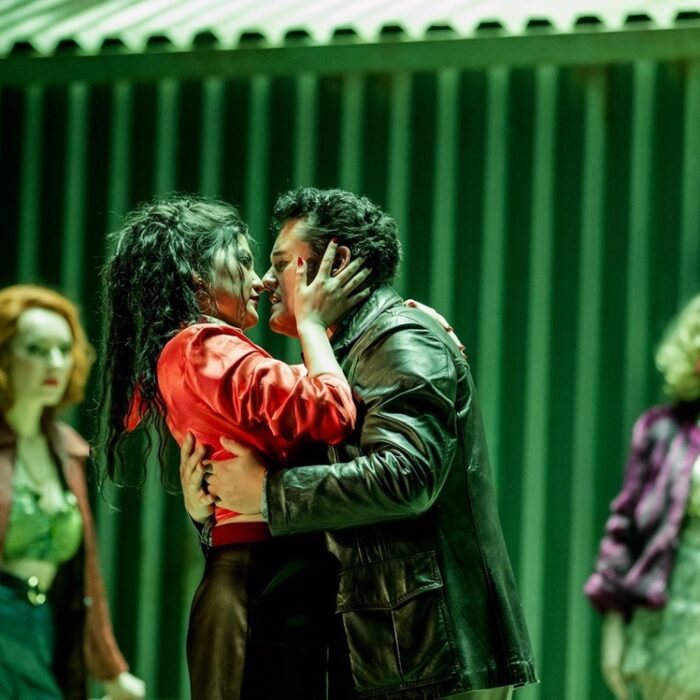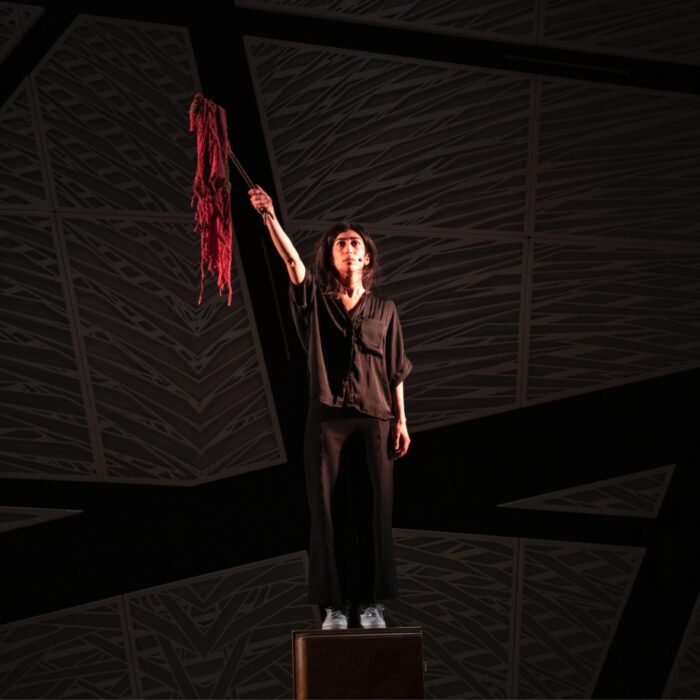
Festival d’Aix-en-Provence 2023 Review: Ballets Russes
A Messy Affair Salvaged by Klaus Mäkelä’s Genius
By João Marcos Copertino(Photo Credit: Jean-Louis Fernandez)
On the website of Aix-en-Provence Festival, the “Ballets Russes” is sold as a fully staged opera. Listing it that way, the festival director Pierre Audi is provoking the audience to see what opera can actually be beyond the screaming divas. Most times, Aix’s provocations pay off. In fact, it is part of the festival’s brand.
In “Ballets Russes,” most of the night was frustrating. But, in the end there was art.
The idea is simple, to play live symphonic music in the futuristic ruins of Stadium des Vitrolles. This place has great acoustics, by the way, and there was avant-garde film projected on a silver screen. Sound familiar? The festival claimed to reinvent the opera, but actually they were doing a less-competent version of Walt Disney’s “Fantasia.” Instead, it was “Aix-en-Orlando, Florida.”
This attempt to expand the idea of Opera falls short not so much because of its unoriginal idea, but because of the artistic incompetence of two of the three invited filmmakers. It is not that the films were bad, because they each had their charms. But, they were incapable of truly capturing the power of live music and gesture, perhaps the two essential aspects of both Opera and Ballet.
Once one accepted being part of “Fantasia 2023,” the experience was sometimes pleasant and eventually even remarkable. The orchestra was superb. Klaus Mäkelä showed why he is one of the most exciting conductors nowadays. The acoustics were amazing. All great prizes for those who could endure being in a room unknown to any AC machine in 98°F weather.
A Messy Affair
All of the films faced the issue about how to achieve synchronicity in a hybrid performance. While the film is a digital copy, with little flexibility in its screening speed, the orchestral music when performed live only flows with a certain freedom of execution. Maybe the most interesting part of the night, beyond the great musical performance itself, was to see how each filmmaker dealt with such hybrid regime of theatricality. Taped image, live music. How synchronized can the music be when the image is already pre-taped? Is not the dance, the gesture, supposed to follow the music? Will the music catch up with the image?
Each of the three filmmakers addressed this issue in their own terms. Rebecca Zlotowski fell short. Bertrand Mandico had great insights that after a while were too witty for their own good. Evangelia Kranioti made art out of it.
I have not been super acquainted with the work of Rebecca Zlotowski prior to this performance, but after seeing her generic attempt to “stage” Stravinsky’s “Firebird,” I might stay away from her work for good. She decided to recycle her critically panned 2016 film “Planetarium” into an image complement for the ballet. The discovery was that compost cannot be recycled. There are not enough severe words for such an artistically weak performance.
The film was overly edited into a confused plot that deals with two sisters, both spiritual mediums, in an artificially staged 1920s. The two telekinetic sisters, played by Natalie Portman and Lily-Rose Deep, earn their pay showcasing their powers in vaudeville theater presentations. In a lavish night they capture the attention of a big film producer, played by a surprisingly charismatic Emmanuel Salinger. The film producer tries to capture the theatre experience on film, but he can’t rescue the magical aspect of the real-life touch. It seems that the peril of the theatrical experience is absent when on camera. The cinema, often represented in the film by mirrors, is as the film suggests, a less dangerous and visceral experience of the “true” theater. The touch of the mediums’ hands show one’s own deep dark secrets.
In the case of Salinger’s character, the dark secret seems to be repressed homosexuality. If the plot itself seems underwhelming, the editing is extremely frenetic and confusing. It never matches the beauty and lyricism of Stravinsky’s music. The film seemed to happen in spite of the music. But the most excruciating aspect was Zlotowski’s incompetence with story-telling. The removal of the film’s dialogue made the plot so hard to follow that the film was hard to watch. It was almost impossible not to feel sorry for Natalie Portman and Louis Garrel’s making a series of meaningless expressions.
Zlowtowski’s claim was that the making of “Planetarium” was surrounded by Stravinsky’s “Firebird.” Given the blatant failure of both cuts of her film, the original film got a 15 percent approval rating on Rotten Tomatoes. Although Rotten Tomatoes is a problematic source, this is an even more problematic percent. One may wonder if there is indeed a certain difficult relationship between the filmmaker and Stravinsky’s music. Maybe in 30 years’ time it will be considered good. However, I do not know if I will be here to see it.
An Improvement, But…
Betrand Mandico’s take on “Petrushka” is way better than Zlowtowski’s on “Firebird.” But, it too was not great. Mandico had the main advantage of doing his film while actually thinking of Stravinsky’s ballet. In fact, his film does not deviate much from Stravinsky’s music and Sergei Diaghilev’s staging. The most interesting of his ideas was to face the issue of synchronicity in a fairly original way. He openly accepts that the images will never fully match a musical movement. Mandico’s film is projected on two different screens simultaneously, emulating his own strabismus in that the images in the left were not the same as those on the right. The effect redefines the rule of synchronicity in a ballet. The images do not seek perfect connection with the music, but rather a broader continuation under the idea of chaos.
Aesthetically, Mandico achieves “Petrushka’s” plot pastiche through a well-curated trashy art design and a 1990s gray TV cinematography. In this, Petrushka is a she-mannequin under the tyrannical and artistic hands of magician/charlatan Tamara, which is a nod to Tamara Karsavina, the lead dancer in the original “Petrushka’s” production. Played by a mesmerizing Nathalie Richard, with an eye-patch that looked like a better version of Madonna’s in the Madame X tour, the plot flows into a mesmeric and aesthetically repulsive storyline not so unlike the original idea of the ballet.
Everything works until it does not. While the film is insightful, it is hard not to tire of the presentation and the symbolic language. Although it is interesting, gradually it loses aesthetic appeal. However, the biggest flaw is that Mandico’s film could never match Stravinsky’s artistic genius, and it did sometimes seem as if it were a competition. While Paris Orchestra shone in the pit, the film seemed not quite there yet. It is like the old saying, the way to purgatory is paved with almost good intentions.
Redeeming the Experience
In my opinion, the best experience of the night was by far Evangelia Kranioti’s take on “The Rite of Spring.” This was so good that I wondered if it would have been better to have shown two of her films and called it a night. It would be amazing to see a double bill of this amazing “Rite of the Spring” and Stravinsky’s “Le Noces” or maybe his “Mass.” Something where singers are required to open their mouths, like an “opera” with voice.
Instead of competing with Stravinsky’s music, Kranioti makes her film a symbolic contemplation of images from the extremes of western society, Brazil and Artic Russia. At these edges of civilization, Kranioti finds the uncomfortable crossroad between primitivism, modernism, and colonialism. Instead of seeking great synchronicity, her images contemplate and sometimes even expand the meaning of Stravinsky’s earthy ballet. There is no attempt at synchronicity with the movement. Her images are contemplative. However, there is something deeper being unmasked. The immense philosophical magnitude of “The Rite of the Spring.”
In a search to expand the meaning of “Springtime,” Kranioti establishes “Winter” as a time of impossibilities. A masked man floating under the frozen water of the Arctic, an indigenous woman drowning in rainwater, and even though she’s inside her shed, a homeless crack-addict in the middle of a highway. These impossible situations are not, nevertheless, preventing life itself. These humans survive despite it all.
Springtime comes when these same characters can thrive in spite of the precarious situation that they encounter. They accept their impossibility by carnivalizing it. This denial is neither of sacrifice, nor of the violence within. There is a beautiful exploitation of the transgender body in the film that could be read as if this body were rendered for a certain form of sacrifice. The issue is that this violence within the rite is celebrated not as a form of civilization, but as the beauty within a new form of barbarism. The political implications of such approach might be thought later, but they are not carelessly done.
Maybe Kranioti’s takes on colonialism are enlightening. She is dealing with a world that has been colonized and made into the periphery of what really matters. At first, that is a harsh manifestation of the enduring connection between modernity and colonialism. The destruction of the world and the homelessness of those who are native to the land. At first, too, the harsh reality seems to be evaded solely through the use of hallucinogens and masks that are beautifully designed by Marcelo Indio. Progressively we are invited to see that these masks are not orthodox Brazilian carnival masks. For example, Kanioti’s springtime shows many children imitating Marvel’s Hulk. Few things might be more problematic than Marvel and its meaning in Latin America. It is a symbol of Americanization and of colonialism, and it even poses a threat to folklore. However, the Hulk here is not only appropriated but incorporated as enjoyment of the primitive. A character that cannot be tamed or civilized. A joyful approach to the monster within. It is the monster that guides us to springtime.
The beauty of Kanioti’s compositions elevates Stranvinsky’s music and leads the mind of the audience to another level of appreciation of Stravinsky’s genius. The film does not compete with the music. It is a reading of Stravinsky’s radicalism that celebrates the great beauty of it. It is an invitation to see “The Rite of the Spring” slightly different, as if all this philosophical depth had always been there, and one failed to notice it before.
Never Better
Much has been said about the image of this performance, but what about the sound? Paris Orchestra has never sounded better! The horns were impeccable everytime they played, despite the many challenges they faced. The strings, especially in “Firebird,” were sublime. The flutes in “Petrushka” are forever ingrained in my memory. And, even though much credit should be given to the musicians for such fine reading of Stravinsky’s ballets, it would be unfair not to attribute such success to Klaus Mäkelä’s talent.
The young Finnish conductor seems to be extremely comfortable in conducting pieces that combine an orchestral grandiloquence that is dear to much 20th century orchestral music, and of great lyricism. His readings are always energetic, but they never sacrifice a search for beauty within the sound and phrasing.
Sometimes, I think Mäkelä is not a conductor, but a philosopher that writes with sound. It seems that his main subject is to expand the power of dramatic expression that an orchestra can reach. If in September of last year I questioned whether Mäkelä’s reading of Jimmy López Bellido “Aino” was indeed the work of a genius, after hearing his Stravinsky, I am more than certain. That said, it is undeniable that Mäkelä and Paris Orchestra work better when the composition of the images share their aestheticism. In this visceral reading, where emotional intensity and aesthetics are so immanent to each other, there is very little room for anyone to be less than optimal.


